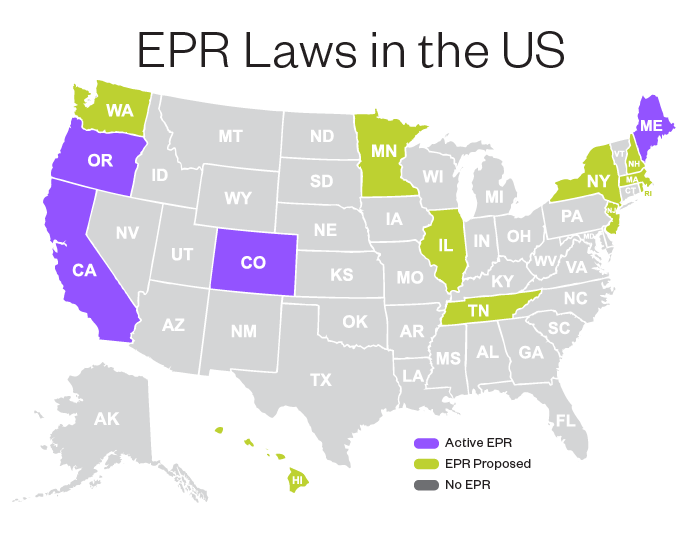Game-Changing EPR Laws Are About to Disrupt Packaging for Good
Extended Producer Responsibility (EPR) legislation is taking effect in many states across the US—and every CPG leader should be prepared. Dominick Mortarotti, Product Strategy Director, and a leader in LPK’s end-to-end packaging solutions, breaks down EPR laws for CPG, explaining how much time brands really have to future-proof their products.
For over a century, consumer packaged good companies have provided high-quality products that fulfill consumer needs at affordable prices. From snacks to personal care, beverages to pet supplies, virtually anything consumers need is at the ready—but this convenience and innovation comes at a cost. The United Nations has reported that a staggering 91% of all plastic is single-use, and since becoming commonly used in packaging in the 1960s, it has accumulated to 8.3 billion metric tons of pollution. With this comes health concerns too, such as exposure to microplastics and nanoplastics, which can increase the risk for serious diseases, stroke, and even death.
Rising Consumer Demand for More Sustainable Products
Understandably, people have reached a breaking point: a study by PDI Technologies found that 80% of consumers are very or somewhat concerned about the environmental impact of the products they buy. In the United Kingdom, demand for sustainable packaging from brands is rising rapidly, with 81% of consumers demanding it for 2024.
“Complying is no longer simply a potential strategy for brands—it’s a legal mandate.”
Responding proactively to these pleas isn’t simply the right thing to do. It’s a tremendous strategy for growth, too: a PDI Technologies study found that products marketed as sustainable grew 2.7 times faster than those that were not. And New York university found similar trends, citing that these sustainably geared products delivered one-third of all annual growth across the CPG market.
Understanding Extended Producer Responsibility (EPR) Laws
Moreover, complying with sustainable guidelines is no longer simply a potential strategy for brands—in many states, it’s a legal mandate. Enter Extended Producer Responsibility (EPR) laws. Simply put, EPR shifts packaging responsibility from the consumer to the producer or importer. AKA, the brand.
This shift in responsibility and fees is managed by Producer Responsibility Organizations (PROs), which work with regulatory bodies to ensure compliance. To all my CPG company friends, you are the packaging importers—and it’s high time to evolve your brand.
“100% of all single-use packaging needs to be recyclable or compostable by 2032. Yes, even the zipper, cap or lid.”
EPR laws in the United States place the responsibility for end-of-life management of products on manufacturers, incentivizing them to design more sustainable and recyclable products.

Growing Momentum of EPR, State by State
The first-ever EPR law in the United States was enacted in 1991 in Minnesota, focusing on the recycling of used paint. Since then, various states have implemented EPR programs for electronics, batteries, packaging, and other products to reduce environmental impact and promote circular economy practices. Across our nation EPR laws are now coming into their heyday.
“EPR shifts packaging responsibility from the consumer to the producer or importer. AKA, the brand.”
Now, more and more states are adopting EPR requirements. For states that already have EPR laws, like California, Oregon and Maine, efforts are underway to create even stricter guidelines. And it is not just the US; all EU Member States are now required to have EPR guidelines as well.

California’s Historic Law + Its Packaging Implications
One of the most pivotal and sweeping EPR laws is California’s, CA SB 54, passed in 2022. The law is historic, as its implications on the CPG packaging industry are game-changing. By 2032, all single-use packaging and food containers manufactured in California must meet new requirements:
- 100% of single-use packaging and plastic food service ware sold in the state is recyclable or compostable
- 65% of single-use plastic packaging and food service ware is recycled
- 25% less single-use plastic packaging and food service ware is sold
The legislation brings sweeping change to a long under-regulated industry. Now, the number of producers and importers (again, that’s brands) impacted will grow from 1,000 to more than 13,500. Those who fail to comply with the new regulations by 2032 may face significant penalties, with proceeds used to support environmental mitigation and sustainability efforts.
That’s right: 100% of all single-use packaging and food containers need to be recyclable or compostable by 2032. Yes, this includes every part, even the zipper, cap, or lid on your otherwise recyclable packaging. Everything.
“Soon enough, consumers won’t see your EPR compliance as a plus. They’ll see it as a non-negotiable.”
How to Future-Proof Your Brand for EPR Laws
Where does that leave us? Consumers want sustainability. But they still want convenience and affordability, too. Achieving this trifecta is a challenge, but consumers will reward companies that get it right.
Where to start? “There’s a lot to think through, but we begin the process with clients by conducting an EPR audit,” says Sam Hartman, a senior strategist at LPK with deep expertise in the sustainable CPG sector. “We assess every aspect of their product and packaging strategy to determine what needs evolution and how we can expedite that process in innovative, creative and cost-effective ways.”
While the average product redevelopment cycle can take 9 months, LPK is employing a mix of co-creation sessions, design sprints, rapid consumer testing and next-gen packaging design to help brands get there quicker. “The reality is, you still need to start with who your consumer is and what your product is solving for them,” LPK Creative Director Alex Lohmann explains. “From there, we can create solutions that drive decision-making at shelf, comply with EPR standards and push your brand forward in greener, more innovative ways.”
“The reality is, you still need to start with who your consumer is and what your product is solving for them.”
Starting with our Discovery phase, we first audit a brand’s products, analyzing if they comply with applicable EPR requirements. As an end-to-end packaging partner, we can then ensure success throughout the product redevelopment process—from legal and material science to tracking and lab testing. The real benefit here: maximizing this moment to not just comply with EPR, but to better resonate with your consumers. Through consumer research and real-time validation, we can ensure that consumers want the product you’re transforming. And if not, we identify the best ways to optimize and improve, no matter the headwinds.
Partnering Directly with Action Groups
Alongside smarter processes, gaining access to partners at the center of this movement is key. LPK is a member of the National Stewardship Action Council (NSAC), a non-profit promoting a circular economy throughout the US, including via work on CA SB 54 regulations and implementation. Intel from this organization can help prepare you to navigate these new laws before your competition does. Heidi Sanborn, Founding Executive Director of NSAC, sees agency partners as key to driving compliance and transforming the CPG industry: “As a consultancy, LPK is positioned to be a catalyst for change, connecting those who are driving EPR regulation and enforcement with the large CPG players that are effected.”
“LPK is positioned to be a catalyst for change, connecting those who are driving EPR regulation and enforcement with the large CPG players that are effected.”
What’s Next for EPR?
As consumers, categories and culture continue to evolve, so will EPR laws, likely becoming more widespread across the US, more stringent in their regulations and more transformative for the CPG landscape. “Soon enough, consumers won’t see your EPR compliance as a plus. They’ll see it as a non-negotiable,” says Lohmann. “The time to enact your transition strategy is now.”
Ready to future-proof your product and packaging for EPR laws? Unsure where to start, but know you need a consultation? Take our EPR Readiness Survey and we’ll get in touch with customized solutions for you.
LPK IS THE LEADING CREATIVE CONSULTANCY.
Through deep discovery and beautiful expression, we help businesses know, grow and innovate for their ever-changing consumers and customers—driving future brand growth and cultural relevance.








